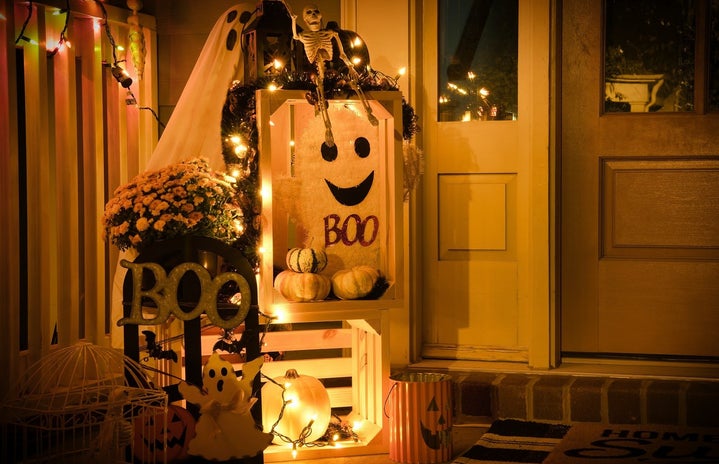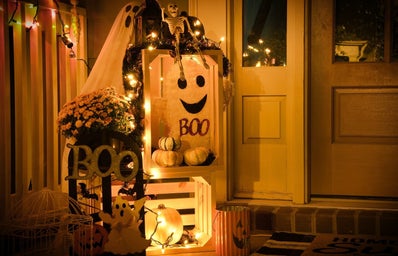Have you ever wondered why we carve pumpkins or take candy from strangers on October 31st? Me too.
Get your gory masks and trick-or-treating bags ready because Halloween is right around the corner! One spooky evening of scary and sexy costumes, free candy, and Tim Burton films.
While this holiday seems like all fun and games (with an extra dash of fright), don’t you think it’s a little…bizarre? Gutting and carving orange pumpkins, terrifying children with a Boo! and jump-scare, or collecting candy with the password trick-or-treat, are not your average festivities. Where do these traditions come from and why?
THE ORIGIN STORY
To begin unpacking Halloween’s origin story, let’s travel back 2000 years to early Ireland, the United Kingdom, and France1…
November 1st: The ancient Celtic festival of Samhain.1 This day served as a transitional period between summer and winter, the season of darkness, coldness, and human death.1 October 31st, the day before said festival, was believed to act as a portal, blurring the lines between the living and dead worlds.1 On this day, the Celts would celebrate Samhain, believing that ghosts would return to the living for the evening1.
To encourage the success of this event, animals and crops would be sacrificed and burned in large bonfires and individuals wore costumes of animal heads and skins.1 Additionally, participants would set extra place settings at their dinner tables and leave lit candles and treats on doorsteps and roads, helping lead their loved ones home.2
After several different settlements to the land, events from other cultures began to intertwine with the Samhain festival, embedding new traditions and celebrations into societies. For example, as the Roman Empire conquered most of the Celtic land, they introduced Feralia, a day to commemorate the dead.1
Additionally, by the 9th century, the uprising influence of Christianity brought All Souls’ Day on November 2nd.1 Similar to the Samhain festival, this event oversaw the production of large bonfires and parades of individuals costumed as angels, devils, and saints.1 It was this event, in addition to Feralia, All Saint’s Day, The Feast of Pomona, and the renaming of Samhain Eve to All-Hallow’s Eve, that created the holiday we are familiar with: Halloween.1
AMERICAN TRADITIONS
Over time, as European, Irish, and American Indigenous beliefs began to intertwine in America, the country developed its own version of Halloween.1 Some of the traditions are still seen today, in both similar and evolved ways.
Trick-or-Treating
In America, Halloween quickly lost its superstitious and religious overtones, focusing more attention on quality time and candy-collecting over witchcraft and bringing home familial ghosts.1 Trick-or-treating started as individuals began to dress up in costumes and go through the neighbourhood asking for treats or money.1
Ghosts
Ghosts have been a recurrent entity since the original Celtic festival of Samhain. While at once individuals wished for their return, we now beg for the opposite! Popular culture has depicted these spirits as fearsome, dangerous, and undesirable, different from how individuals once thought them to be. For instance, consider Ghostbusters or the Paranormal Activity series where ghosts play the antagonists.
Black Cats
Originating back in the Middle Ages, individuals believed that witches could transform themselves into this spooky species as a means of secrecy and hiding.1 Overtime, black cats evolved into a symbol of bad luck. This is a symbol we still see today, and particularly during the Halloween season.
Jack-O’-Lanterns
Root or vegetable carving was first popular in the United Kingdom. Its purpose was to scare off Stingy Jack and other evil spirits.2 Stingy Jack is a legend about a man who made deals with the devil for material goods and personal protection.2 However, when Jack died, neither God nor the Devil let him enter Heaven or Hell, leaving him alone, wandering the earth with a lit-up turnip to guide him.2 Eventually, this UK tradition seeped into North America, inspiring us with our own rituals of pumpkin carving and lighting, brightening our front porches on Halloween night.
21st CENTURY CHANGES
Traditions are ever-changing. During the COVID-19 pandemic, Halloween took a break; many streets cancelled trick-or-treating to protect families from the spread of the virus. In the years following the pandemic, fewer kids dressed up, more houses kept their lights off than on, and individuals ended up with more candy than they gave! Perhaps, like most things post-pandemic, re-building Halloween is a slow-burning process. Perhaps, the pandemic is not the reason for Halloween’s decline at all, and the technological uprise in society has simply corrupted our spirit!
Despite the mystery that only saddens me to contemplate, I believe that if this holiday was able to withstand thousands of years of change, many catastrophes, and several deathly plagues, then I am beyond optimistic that it can survive the 21st century. The only catch is, it’s our responsibility to help it!
Happy Halloween!
References:
- Halloween: Origins, meaning & traditions. (n.d). Retrieved from https://www.history.com/topics/halloween/history-of-halloween
- How Jack O’Lanterns originated in Irish myth. (n.d.). Retrieved from https://www.history.com/news/history-of-the-jack-o-lantern-irish-origins


